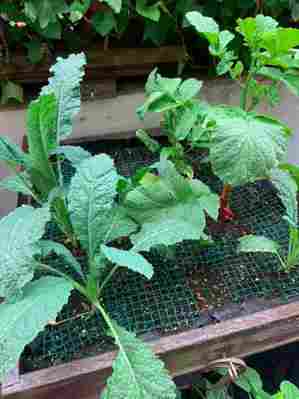
I didn’t grow up with a lot of plants, or even with parents who gardened for fun. Still, I’ve somehow found myself at 28 with somewhere between 20 and 30 plants — a tale as old as a millennial’s sense of time, right? And despite what I thought was a complete lack of skill and a pretty significant lack of outdoor space, I’ve found myself with a small back patio full of fresh produce.
Though the space is filled with mostly vegetables and herbs, the garden really started with a lemon tree that my husband and I bought on a whim from a local home improvement store’s gardening section. For two years, we watered and cared for the tiny tree without really knowing if it would ever produce fruit. Keeping it alive felt like a win in and of itself, and when the tree finally did flower and produce a teensy tiny lemon, it felt like winning the lottery. We were hooked, and started getting curious about what else could we grow and where we could grow it.
As it turns out, our back patio — which comes in at less than 40 square feet, also houses a small grill and a shed that we use for recycling, and has exactly zero soil — turned out to be the perfect space for us. These days, we use the space to grow more than a dozen types of fruits and vegetables. Here are the habits, tools, and mindsets that have helped.

Start small.
Even after I started collecting houseplants, outdoor gardening always intimidated me. It felt like something you had to study or completely understand to get just right. This may be somewhat true for large-scale gardens, but when you’re starting small, it doesn’t have to be that complicated at all. In other words: It can just be for fun.
This is why my number one suggestion for city gardening is to start small — and yes, growing an herb or two in your windowsill or fire escape counts! Who says you have to start with a thoroughly-planned layout? Whether you want to start with fruit or vegetable seeds or plant a bunch of herbs that have already grown a bit, start with one or two plants in the spring and summer and go from there. You’ll slowly figure out which areas of your space work for nourishing the plants the best.
If you have the space, invest in a raised garden bed.
My husband and I kicked off our love of city gardening with a raised garden bed someone bought us from our wedding registry. It was an impulse add — something that I wasn’t even sure would get checked off the list, or if we needed it at all. It was a game-changer, however, and allowed us to plant eight different types of vegetables and herbs all at waist-level, instead of on the ground in pots. It also made it easy to figure out which parts of the patio got the best sun, and to move around the different vegetables and herbs accordingly.
Or, if you’re on a budget, use an old drawer!
When we outgrew the raised garden bed and wanted to make more room for different types of vegetables like kale and other heatier leafy greens, my husband decided to take an old drawer we had in the basement and turn it into another garden bed. There are a ton of tutorials online for how to do this, but the concept is a good reminder that any container can be a garden bed with a little creativity. Invest in some landscaping fabric, drill some holes in the bottom of the container, add soil and seeds, and you’re good to go.
Chicken wire is your friend — even in a city.
When your plants are just getting their start in the soil, it’s especially important to protect the seeds and seedlings from adverse environments — and squirrels absolutely count. This doesn’t mean you have to build a fancy enclosure or use any chemical deterrents. Instead, invest in some simple chicken wire — animals like squirrels, birds, and raccoons hate it, and you can bend and curve your wire so your plants have something to hold onto as they grow higher.
Look out for pests.
Not having a ton of experience with gardening often means I’m easily confused when it comes to pests and bugs. In my experience, any time I notice a weird pattern on leaves (small white dots are a big no-no, as they’re usually aphid eggs ), I spray the plant with a gentle cleaning solution. My go-to is Branch Basics’ all-purpose cleaner , but as the Farmer’s Almanac suggests, most soapy water solutions will work for getting rid of pests, too.
After thoroughly covering the plants with the solution, I wash the cleaner (and any pests) off with water. Doing this once or twice every few months has been key to maintaining healthy, pest-free plants.
Try not to take it too seriously!
When people ask me for my tips for gardening in a city, the first thing I always say is: It’s not as complicated as you think it is. It doesn’t have to be elaborate, or perfect to be rewarding. In fact, the less seriously you take the entire endeavor, the more fun it becomes. A failed crop or some trial-and-error isn’t going to make or break your experience. In fact, that’s just part of gardening.
Though I dream of one day having a lush, sprawling garden in a giant backyard, I am pretty confident that the joy I get out of gardening now feels exactly the same as it would in a bigger space. The simple pleasure of stepping out your backyard and grabbing a handful of something you’ve grown from nothing for a recipe is unmatched, whether your backyard is a 10-acre farm or just 40 square feet in the middle of Philadelphia.












